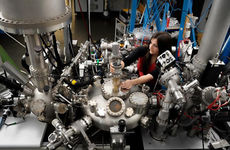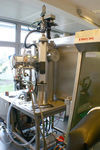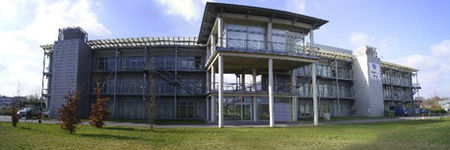Description of the organisation
Materia Nova is a Research Center established in Mons (Belgium) in 2000 with a staff of almost 100 recognized scientists. The major goal of Materia Nova is to extend the research activities of its academic affiliates towards industrial applications. This implies very active collaborations with local and international companies in the fields of chemistry, materials, and energy. Materia Nova encourages the transfer of technologies between the world of basic research and the industrial world for a large number of applications such as multifunctional surfaces, advanced materials and solutions for energy applications, innovative and sustainable polymer materials, cells for materials and materials for cells, Life Cycle Thinking. Materia Nova offers a platform of technologies for Organic Electronics, Chemical sensors, anti-corrosion coatings, electrochemical coatings, plasma technologies, polymer and composites, sol-gel and wet coatings.
In MMAMA, the Laboratory for Chemistry of Novel Materials at Materia Nova will bring its strong expertise in:
- the morphological, electronic, optical, and transport properties of organic and hybrid (semi)conducting materials in thin films;
- the chemical nature, the structure, and the electronic properties of organic/organic and organic/inorganic interfaces; This expertise is achieved through a joint theoretical – experimental approach including:
- the multiscale modelling of materials and opto-electronic processes
- the thin film deposition with controlled organization of the materials and characterization of microscopic morphology, including Scanning Probe Microscopies (AFM, C-AFM, SSRM and KPFM)
- the fabrication of Organic PV, Hybrid PV and OLED’s devices and the characterization of their performances.
Materia Nova will also bring its growing experience in the field of ion implantation of materials, through its participation in the Walibeam platform dedicated to “industrial ion implantation technologies for cutting-edge materials”. Targeted applications in the platform include surface conversion, improvement of friction properties, improvement of corrosion resistance, but also coatings with surface electrical charge dissipation, which could directly benefit from the SMM technologies.
In MMAMA, Materia through its collaboration with Asahi Glass Company will provide a series of relevant reference ion-implanted glasses for the validation of SMM. Considering current materials developments at Materia Nova, additional applications in ion-implanted polymers could also be considered.
Significant infrastructure / major items of technical equipment
For the experimental activities regarding the fabrication of reference thin coatings dedicated to PV applications, Materia Nova will bring to the consortium a broad range of facilities for the fabrication and characterization of the coatings before SMM analysis. This includes a number of liquid-phase deposition techniques: spin coating, Dr blading, spray coating (both in ambient and glovebox conditions). Materia Nova also uses two multi source thermal deposition systems coupled with gloveboxes (KJL Leskers Spectros (11 sources, 10 x 10 cm2) and Super Spectros (15 sources, 20 x 20 cm2), to fabricate complex architectures combining solution processed and thermally-sublimed layers.
Besides an integrated set-up for the characterization of the performances of PV devices, Materia Nova also offers state-of-the-art analytical tools to determine the chemical composition and physical properties of materials: (i) X-ray diffraction techniques, (ii) surface analysis techniques (XPS, TOF-SIMS), (iii) electrical (4-point probe, Hall effect) and optical (UV-VIS) measurements, and (iv) microscopy techniques (OM, SEM, TEM, C-AFM, KPFM).
Main contact
Main publications related to the project
Books contribution
- M. Surin, G. Derue, S. Desbief, O. Douhéret, P. Viville, R. Lazzaroni and Ph. Leclère, “Functional Supramolecular Architectures: For Organic Electronics and Nanotechnology” Functional Supramolecular Architectures, 491-526 (2014), ISBN: 9783527326112
Articles
- L. Letertre, O. Douhéret, M. Bougouma, T. Doneux, R. Lazzaroni and C. Buess-Herman “Nanoscale study of MoSe2/poly(3-hexylthiophene) bulk heterojunctions for hybrid photovoltaic applications”, Solar Energy Materials and Solar Cells, (2015), DOI: 10.1016/j.solmat.2015.08.027
- D. Moerman, N. Sebaihi, S. E. Kaviyil, Ph. Leclère, R. Lazzaroni and O. Douhéret,“Towards a unified description of the charge transport mechanisms in conductive atomic force microscopy studies of semiconducting polymers”, Nanoscale, 6, 10596-10603 (2014), DOI: 10.1039/C4NR02577F
- M. Agbomahena, O. Douhéret, B. Kounouhewa, A. Vianou, N. Awanou and R. Lazzaroni “Ageing of organic photovoltaic devices in Benin environment (South-Sudanese climate)”, Solar Energy Materials and Solar Cells, 117, 93-97 (2013)
- S. Desbief, N. Hergué, O. Douhéret, M. Surin, Y. Geerts, Ph. Dubois, R. Lazzaroni and Ph. Leclère, “Nanoscale investigation of the electrical properties in semiconductor polymer - carbon nanotube hybrid materials”, Nanoscale, 2012, 4, 2705. DOI: 10.1039/C2NR11888B
- D. Moerman, R. Lazzaroni and O. Douhéret, “Efficient bulk heterojunction photovoltaic cells with a pre-organized poly (3-hexyl thiophene) phase”, Applied Physics Letters 99, 093303 (2011)
- Mathieu Surin, Gwennaëlle Derue, Simon Desbief, Olivier Douhéret, Pascal Viville, Roberto Lazzaroni, and Philippe Leclère, “Scanning Probe Microscopy insights into supramolecular π-conjugated nanostructures for optoelectronic devices”, in "Functional Supramolecular Architectures for Organic Electronics and Nanotechnolgy edited by F.Cacialli and P.Samori (Wiley VCH)", Wiley (2011)
- Philippe Guaino, Fabrizio Maseri, Renaud Schutz Michael Hofmann, Jan Birnstock, Ludovic Avril, Jean-Jacques Pireaux, Pascal Viville, Hani Kanaan, Roberto Lazzaroni, Jerome Loicq, Frank Rotheudt and Christian Pans, “Large white organic light-emitting diode lighting panel on metal foils”, J. Photon. Energy. 2011, 1(1), 011015.
- Loicq J., Fleury-Frenette K., Viville Pascal, Lazzaroni Roberto, Kanaan H., Guaino Ph., "OLED Light Extraction Improvement with Surface Nano-micro Texturation Based on Speckle Lithography" , in “Physics and Optics of OLEDs“, SPIE Photonics Europe 2012
- F. Boon, S. Desbief, L. Cutaia, O. Douhéret, A. Minoia, B. Ruelle, S. Clément, O. Coulembier, J. Cornil, P. Dubois, R. Lazzaroni, “Synthesis and Characterization of Nanocomposites Based on Functional Regioregular Poly(3-hexylthiophene) and Multiwall Carbon Nanotubes” Macromolecular Rapid Communications 31, 1427 (2010).
Key people involved
Dr. Pascal Viville (Age 47) is Project Manager and Scientific Coordinator at Materia Nova since 2006.
He is (co)author of ~50 publications. His current activities concern: (1) setting-up and leading research projects dealing with the fabrication and characterization of opto-electronic devices (OLED's: Organic Light Emitting Diodes and OPV's: Organic Photovoltaics) and building connections with industrial partners and European and Belgian research institutes. Type of business: applied research, strategic partnership with industrial companies, test and analysis, scientific advice and consultancy.
Dr. Olivier Douheret (Age 41) is a senior post-doc fellow at Materia Nova since 2007. His main activities concern Research and Development in organic and hybrid electronics within academic and industrial projects. He is currently active in projects for lighting and photovoltaic applications, working on the fabrication and characterization of organic photovoltaic devices (OPV), on self-assembled molecules-based systems and on Organic Light Emitting Diodes, with a special emphasis on the monitoring of technological developments and the transfer of technology for industrial applications. He is also an expert in the nanoscale studies of the morphological and electrical properties of organic and hybrid semiconducting nanostructures using AFM-based scanning probe microscopies.
Dr. David Moerman (Age 30) is a materials physicist and metrology expert specialized in the fields of semiconductor physics, optoelectronics and scanning probe microscopy, with a focus on (hybrid) semiconducting materials and their integration into photovoltaic devices, field effect transistors, and lighting applications. After a two-year postdoctoral stay at the University of Washington (in the group of David Ginger), he is currently a research scientist jointly at Materia Nova and the University of Mons, working on the development of electrical scanning probe microscopy techniques and perovskite-based devices.
Prof. Roberto Lazzaroni (Age 55) is Research director at Materia Nova, full professor and Vice-Dean of the Faculty of Sciences at the University of Mons. His research interests mostly deal with the structure and electronic properties of organic and hybrid supramolecular structures, constructed by self-assembly of functional (macro) molecules. He is (co)author of ~380 publications. (160 since 2007). Citations: > 11000 (7900 since 2007), per publication ~ 29, h-index = 53 (source Scopus). Talks and seminars: 67 delivered worldwide.








